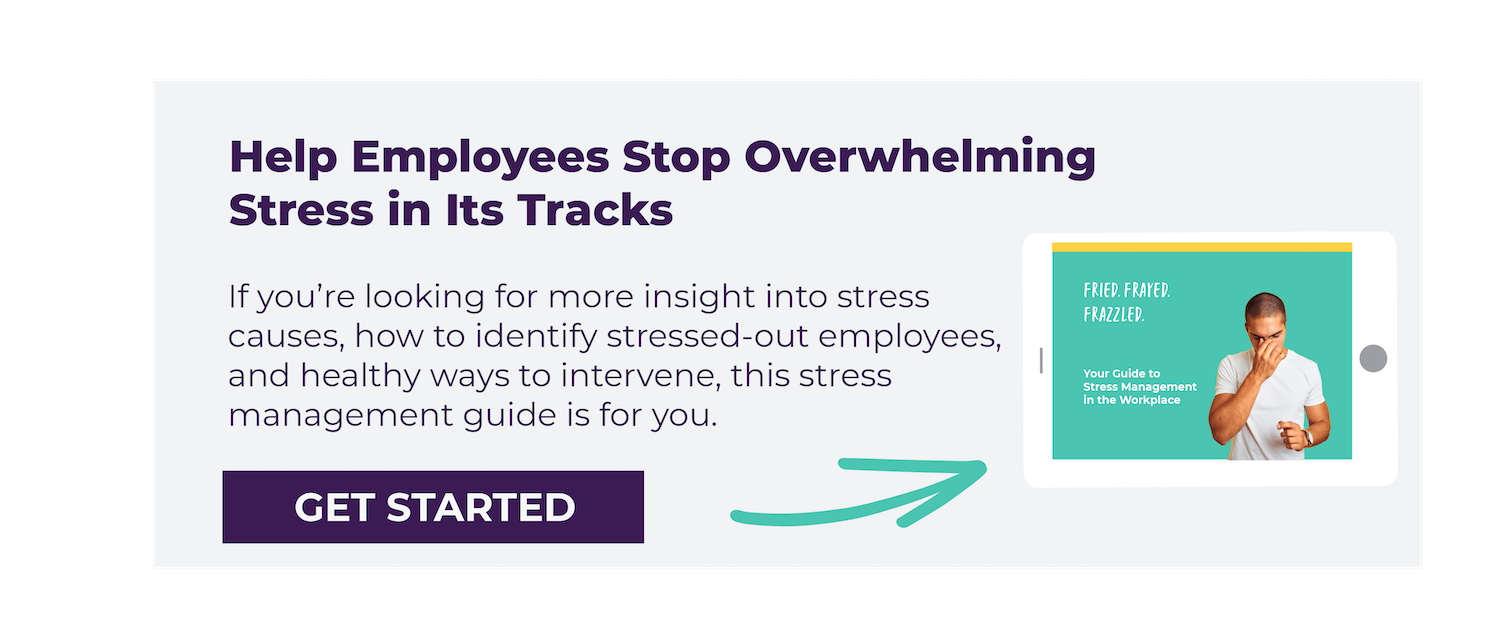Stress is one of the most common challenges employees face. It’s also one of the most damaging, too. Unmanaged stress can lead to burnout, unhealthy habits, and harm an employee’s mental and physical health.

According to research from the American Institute of Stress (AIS), 40% of employees reported their job was very or extremely stressful, and 25% view their jobs as the number one stressor in their lives. Based on these stats, it’s safe to assume that a majority of your workforce is dealing with workplace stress on a daily basis.
While stress might seem like it’s a normal part of office culture, it shouldn’t ever be excused or ignored. When stress becomes chronic, it can have dangerous effects on an employee’s health and wellbeing. In fact, AIS also found that job stress is more strongly associated with health complaints than financial or family problems are.
Chronic stress can lead to health problems such as:
- Headaches
- High blood pressure
- Chronic aches and pains
- Trouble sleeping or insomnia
- Irritability
- Weight gain or weight loss
- Weak immune system
- Chest pain and rapid heartbeat
- Fatigue
- Stomach issues (nausea, diarrhea, constipation)
- Increased risk of anxiety and depression
Not to mention, unmanaged stress can have disastrous consequences in the workplace. Stressed employees often have trouble concentrating, struggle to stay productive, and are susceptible to burnout.
Fortunately, employers have the opportunity to address workplace stress and help reduce its effects in the office. One of the best ways to do this is by focusing on stress management in your workplace wellness program.
Implementing a Stress Management Program
Offer stress education.
Many employees don’t do anything about their stress because they aren’t aware of its negative health consequences. That’s why stress education is so important in the workplace. Employers can help employees better manage their stress by offering stress education and helpful resources. Consider bringing in a healthcare professional to speak about stress management techniques, host regular lunch and learns about stress, and email resources such as tip sheets and informative videos. Require employees to participate in some of the stress-related educational opportunities to be eligible for a wellness reward.
Host stress-related challenges.
Everyone loves a good wellness challenge. They’re fun and engaging, plus they help employees develop healthy habits. Create wellness challenges that help employees manage their stress. Some ideas include:
- Self-care challenge: Challenge employees to practice at least 10 minutes of self-care each day for six weeks
- Meditation challenge: Challenge employees to meditate for at least five minutes every day for 30 days
- Journaling challenge: Challenge employees to keep a mood journal and track their feelings of stress every day for six weeks
- Breathing challenge: Challenge employees to learn one new breathing technique to practice each week for 10 weeks
- Walk when you’re stressed challenge: Challenge employees to take a quick walk whenever they are feeling stressed or overwhelmed
Offer on-site meditation classes.
Offering on-site meditation classes is an excellent way to help employees relieve some stress and teach them healthy coping techniques. Research has found that meditation is an effective way to reduce stress, anxiety, and depression. Plus, it even helps promote productivity, office morale, and resiliency. Consider bringing in a meditation expert to lead one 30-minute session once a week.
Foster an authentic culture of wellness.
A culture of wellness helps employees live their healthiest and happiest lives. A strong culture of wellness will promote healthy habits in the workplace – like getting enough sleep, exercising regularly, and maintaining a balanced diet. All of these factors help reduce the stress in employees’ lives. An authentic culture of wellness will also support employee morale and boost positivity – which are both essential in reducing workplace stress.
Promote a positive work-life balance.
Use your wellness platform to encourage employees to take advantage of any flexible policies at your workplace. A positive work-life balance helps reduce stress and eliminate the stressors of a strict work schedule. Encourage employees to take advantage of flex hours, remote working, and mental health days when they are feeling overly stressed and need a break.
Provide opportunities for stress-relief.
Offer employees the opportunity to participate in stress-relieving practices while they’re at work. Offer on-site chair massages, yoga classes, and lead employees in breathing exercises before meetings.
Workplace stress doesn’t have to damage your employees’ health and work performance. Utilize your workplace wellness program to help employees manage and cope with stress in a healthy way.
Does your employee wellness program address stress? Leave us a comment below!
Like this blog post? Share it with your employees or co-workers with this printable version of the blog!
Image created by Creativeart - Freepik.com



